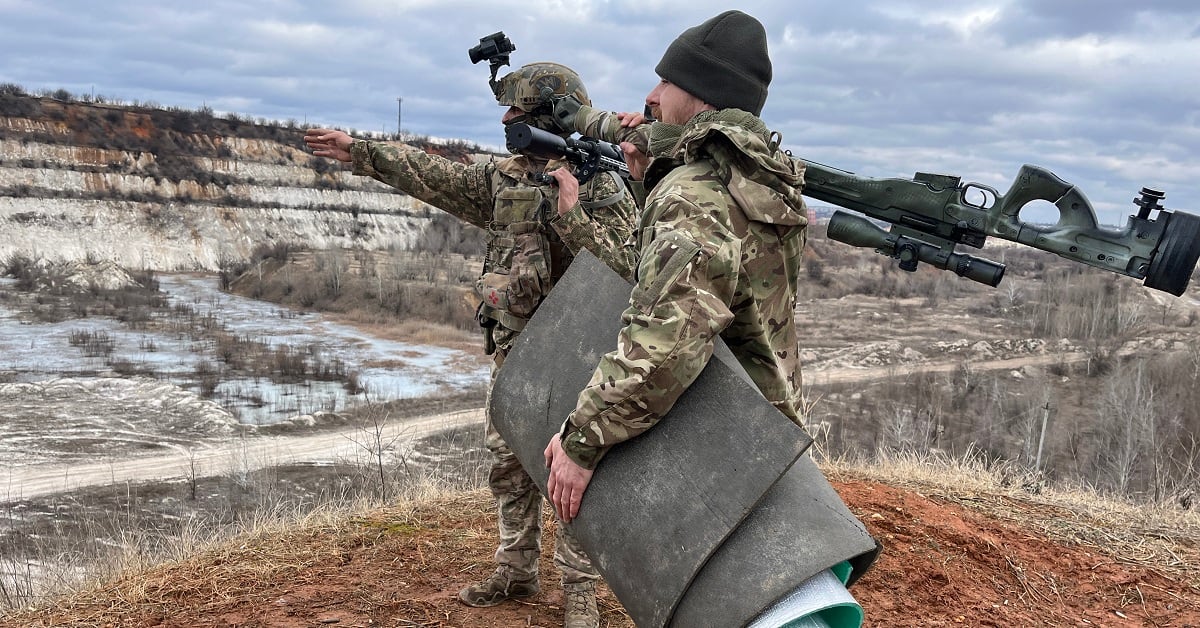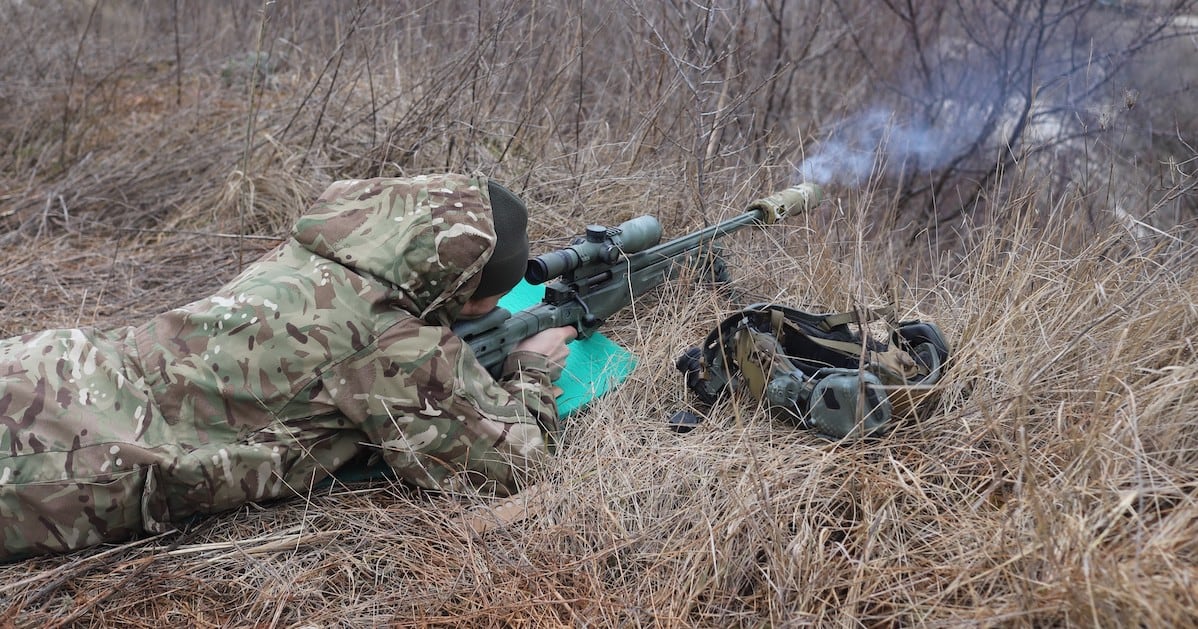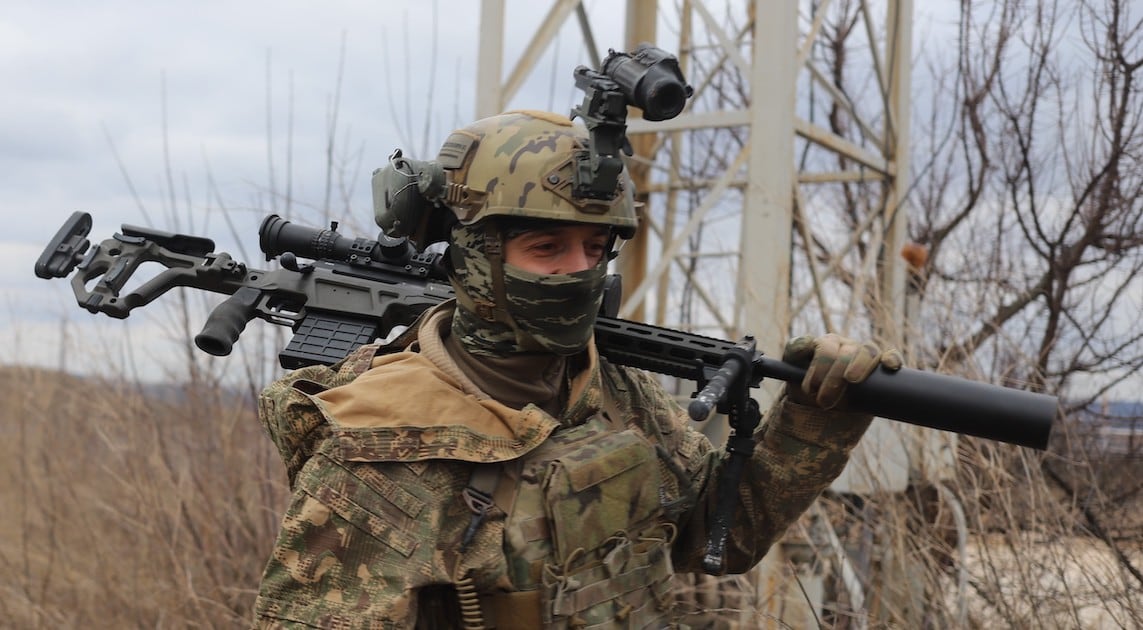DONBAS, UKRAINE — “Sector clear,” calls out the instructor, Artyom, to his student Yevhen. The latter man shifts his rifle slightly, its long British-made barrel resting just above the ground as Yevhen lays prone.
“Target in sights,” he says in Ukrainian as he rests his crosshairs on a man-shaped metal panel in the quarry below a half-kilometer away. He pulls the trigger: a sharp crack, and the smell of gunpowder in the air. Artyom continues to peer through his binoculars into the quarry.
“Target hit,” he says, with a note of approval.
Artyom and Yevhen are training here at a makeshift firing range in eastern Ukraine, just a few dozen miles from the fierce battle for the city of Bakhmut, keeping sharp for when their deadly skills will be called on again. It’s early March, and around Bakhmut, both sides are dug in behind armor or mud, sheltering from 24/7 artillery fire, and occasionally darting from cover to open fire on an enemy trench position. The two snipers’ go-to guns in that type of fight are Kalashnikovs — a weapon well-suited to unleashing a wall of ammunition at close range.
RELATED

“Over the last six months, there hasn’t been much use for snipers — the frontline has been changing quite a bit,” Artyom says. “Instead, we have largely been working as saboteurs: planting mines, destroying train tracks” before the enemy can capture and use them, and carrying out reconnaissance for raids.
But when the Russians have spent their energy on the latest offensive, make camp and take a knee before the next one, the snipers will take to the shadows again, to take them out.
The men have repurposed a deserted stone quarry for their target practice — a wide, rock-strewn depression gouged out of miles of farmer’s fields clogged with mud from the springtime thaw. Yevhen is younger, having joined Ukraine’s armed forces as Russia invaded last year; he is now honing his skills in long-range firearms. Artyom is a professional sniper, having worked in this role since he joined Ukraine’s army in 2016.
Top-of-the-line rifles
For today’s session, each man has a personalized, top-of-the-line sniper rifle to work with. Yevhen to a .308 calibre Accuracy International model; Artyom prefers his Italian-made .338 Victrix Scorpio V. The Western, NATO-style loadout of each marksman is an evolutionary shift from the Soviet approach that characterized Ukraine’s armed forces in years past.
“The U.S., UK, Canada — these countries are the pinnacle of modern equipment,” Artyom says, his outfit bristling with optics and auxiliary gear. “What they use, we try to emulate.” The two men spoke anonymously because they were talking without Ukrainian army permission, in order to speak freely about the course of the war.
While most of their countrymen are fighting in large, coordinated maneuver formations of tanks, artillery and infantry, the two snipers are part of the elite light-infantry force striking from the shadows, using some of the most advanced equipment in Ukraine’s arsenal. Their operations helped drive Russian forces out of western Ukraine in the opening weeks of the 2021 invasion, picking off senior enemy officers at long range, inspiring fear, and confusion among the ill-prepared and disorganized Russian ranks. It’s their tactics that NATO chiefs are studying, as a playbook to what U.S. and other troops might face, should Moscow attack NATO territory.

That kind of warfare was particularly vital in the first six weeks of the Russian invasion as well.
As Russian armored units lumbered through the Ukrainian countryside in late February and early March 2022, the conditions for the sniper warfare that had dominated the not-so-frozen conflict along the frontlines in Donbas since 2015 evaporated.
Instead, mobile strike teams capable of taking on isolated Russian columns, often operating without the requisite infantry cover, became the priority. Composed of both veteran and irregular partisan fighters, small teams of Ukrainian infantry inflicted outsized losses on Russian units.
While neither Yevhen nor Artyom ever worked behind Russian lines, they admit that there was “hardly such a thing” as proper frontlines in those hectic first weeks, before Moscow abandoned the fight for northern Ukraine to focus on Donbas.
In the months that followed, Arytom redeployed to Donbas as well. He describes several close brushes with death since then.
“Sniper duels are just a silly thing from the movies,” Artyom says. “When [the Russians] really want to get us, they use mortars — or if we’re really unlucky, white phosphorus.” The latter substance – an incendiary agent whose use as a weapon is banned in most cases by international law – was deployed against Artyom and his comrades in the village of Bilohorivka just last month. “Everything was on fire. We were lucky to escape that time,” Artyom says.
For Artyom, the war didn’t start with Russia’s full-scale invasion last February. A native of Kramatorsk, he was living in that city when Russian-backed separatists occupied it for several months in 2014 — an experience he credits for his desire to join the armed forces.
“Back in 2014, I was a normal guy, just working in a heavy machinery factory,” he says. “What happened was almost surreal. I couldn’t believe that just 20 guys can capture a whole city – that 500 policemen can just defect or flee,” Artyom says of the Russian separatists’ brief capture of Kramatorsk during Russia’s seizure of Crimea.
He aided Ukraine’s armed forces during the 2014 occupation, providing them with coordinates of separatist troops and bases. “It was pure chaos in those days – gangs looting stores, kidnapping people. I couldn’t imagine that happening to the rest [of Ukraine]. Those days affected me a lot,” Artyom says. He joined the army two years later.

Battle for Bakhmut
Despite his specialized equipment, the expert sniper says his weapon of choice these days in the fighting around Bakhmut is not his cutting-edge Western rifle, but rather, a simple Kalashnikov automatic, equipped with a thermal scope.
“Believe it or not, this, with the proper optics is the most effective weapon I’ve used in this war,” Artyom says, holding up his go-to machine gun. “A sniper rifle costs $20,000 or $30,000 dollars and can kill only one Russian quickly. An AK can defend against an entire assault.” His record in a single engagement? 15 enemies eliminated in about three hours. “We didn’t expect them to react so calmly once we started shooting, but they just kept milling around in the same area,” Artyom says.
Neither Artyom nor Yevhen knows where their next deployment will be. All they are certain is that it won’t be in Bakhmut, the city where six months of brutal fighting has brought Russian troops to within a few kilometers of encircling the Ukrainian defenders.
“There’s not much need for snipers in Bakhmut,” Yevhen says. “It’s the kind of battle that is decided by artillery and regular infantry. There’s no sense to risk highly specialized troops when shelling will kill you just as easily,” he says.
But Artyom has a few interesting ideas for assignments further down the road.
“Since we’re specialists, we get to choose a lot of our own missions,” he says. “I’d like to go next to either the forests of Belarus or the mountains of the North Caucasus. Ukraine isn’t the only country that needs to be liberated from the Russians.”
Neil Hauer is a freelance reporter covering the war in Ukraine and the Caucasus at large. You can follow him on Twitter at @NeilPHauer.



